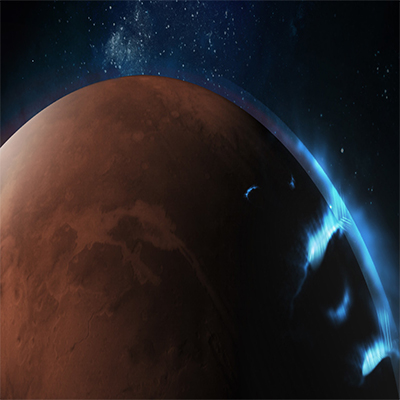Ø The UAE’s Hope spacecraft, which is orbiting Mars since February this year, has captured images of glowing atmospheric lights in the Red Planet’s night sky, known as discrete auroras.
Ø The UAE Space Agency said that the data gathered by the oribter “include far and extreme ultraviolet auroral emissions which have never been imaged before at Mars.”
Ø “The beacons of light that stand out against the dark night side disk are highly structured discrete aurora, which traces out where energetic particles excite the atmosphere after being funneled down by a patchy network of crustal magnetic fields that originate from minerals on the surface of Mars.”
Ø Unlike auroras on Earth, which are seen only near the north and south poles, discrete auroras on Mars are seen all around the planet at night time.
What causes an aurora on Earth?
Ø Auroras are caused when charged particles ejected from the Sun’s surface — called the solar wind — enter the Earth’s atmosphere. These particles are harmful, and our planet is protected by the geomagnetic field, which preserves life by shielding us from the solar wind.
Ø However, at the north and south poles, some of these solar wind particles are able to continuously stream down, and interact with different gases in the atmosphere to cause a display of light in the night sky. This display, known as an aurora, is seen from the Earth’s high latitude regions (called the auroral oval), and is active all year round.
Ø In the northern part of our globe, the polar lights are called aurora borealis or Northern Lights, and are seen from the US (Alaska), Canada, Iceland, Greenland, Norway, Sweden and Finland. In the south, they are called aurora australis or southern lights, and are visible from high latitudes in Antarctica, Chile, Argentina, New Zealand and Australia.
So, how are Martian auroras different?
Ø Unlike Earth, which has a strong magnetic field, the Martian magnetic field has largely died out. This is because the molten iron at the interior of the planet– which produces magnetism– has cooled.
Ø However, the Martian crust, which hardened billions of years ago when the magnetic field still existed, retains some magnetism. So, in contrast with Earth, which acts like one single bar magnet, magnetism on Mars is unevenly distributed, with fields strewn across the planet and differing in direction and strength.
Ø These disjointed fields channel the solar wind to different parts of the Martian atmosphere, creating “discrete” auroras over the entire surface of the planet as charged particles interact with atoms and molecules in the sky– as they do on Earth.
Ø Studying Martian auroras is important for scientists, for it can offer clues as to why the Red Planet lost its magnetic field and thick atmosphere– among the essential requirements for sustaining life.
Ø Hope orbiter: The Hope Probe, the Arab world’s first mission to Mars, took off from Earth in July, 2020 and has been orbiting the Red Planet since February, 2021.
Ø The primary objective of the mission is to study Martian weather dynamics. By correlating the lower atmosphere and upper atmosphere conditions, the probe will look into how weather changes the escape of hydrogen and oxygen into space.
Ø By measuring how much hydrogen and oxygen is spilling into space, scientists will be able to look into why Mars lost so much of its early atmosphere and liquid water.
Ø It is expected to create the first complete portrait of the planet’s atmosphere. With the information gathered during the mission, scientists will have a better understanding of the climate dynamics of different layers of Mars’ atmosphere.


